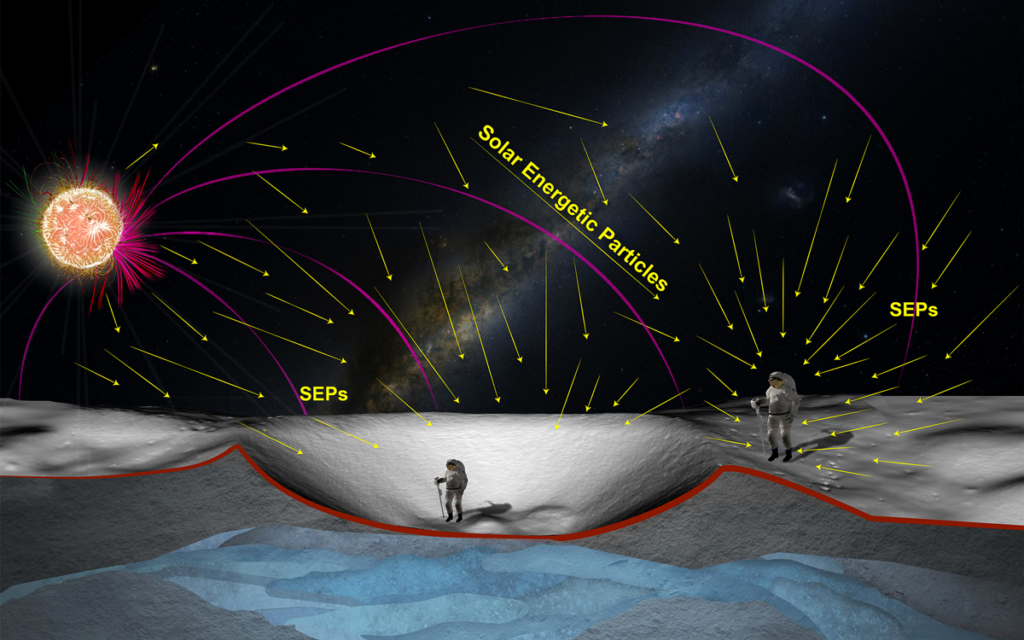In October 1989, the Sun spit a blast of high-energy particles into the solar system. Earth’s protective magnetic field kept us safe, but the Moon received an intense dose: More than 8 times the radiation received by plant workers during the Chernobyl nuclear disaster scorched the barren lunar surface.
As NASA’s Artemis III mission prepares to return explorers to the Moon in 2025, scientists are working to protect them from this kind of unpredictable outburst from the Sun and other radiation from deep space. To do this, they’re turning to the Moon’s natural barriers.
“If one of these storms occurs, we need to protect our astronauts and bring them home safely.”
By mapping the topography of the lunar surface, researchers have calculated the shielding potential of each mountain range, crater wall, and shadowed slope near the south pole—Artemis III’s target. Their work will guide decisionmaking for the landing location of this mission and beyond.
“As we reach the solar maximum, these storms occur more frequently,” said lead author Phillip Phipps, an astrophysicist at the University of Maryland, Baltimore County, and NASA’s Goddard Space Flight Center. “If one of these storms occurs, we need to protect our astronauts and bring them home safely.”

Natural Radiation Shields
In space, astronauts are bombarded with radiation from all sides. Particles from the shock waves of supernovas provide a constant hum of low-level radiation, but that is a minimal health risk to astronauts. The Sun, however, occasionally throws out intense bursts of proton radiation, as it did during the 1989 solar storm.
Artemis III’s landing craft will be designed with solar radiation in mind. But whether the lander alone will protect its delicate human cargo from the most intense solar storms is unclear. Astronauts will not stray far during this mission, but NASA is striving to eventually construct permanent habitats on the Moon. As astronauts use rovers and explore more distant spots from their home base, how will they remain safe?
Using the worst-case scenario of the 1989 solar flare, Phipps and his colleagues measured the potential radiation to which astronauts would be exposed at different spots on the surface surrounding the lunar south pole.
With data from the Lunar Orbiter Laser Altimeter on NASA’s Lunar Reconnaissance Orbiter, the researchers charted the terrain at a resolution of about 240 meters. Then, they calculated the dose of radiation an astronaut would receive at each point by mapping the directions and angles of high-energy particle impacts from the Sun, which is always near the horizon at the Moon’s south pole.
All 13 current candidate landing sites for Artemis III are in the clear, the team determined. Each site offers enough protection in a solar storm when combined with the shielding of the lander, with some performing slightly better than others. The research also showed that even during an intense blast from the Sun, getting low to the ground in a small crater could reduce radiation exposure by up to 50%, potentially saving an astronaut’s life.
The researchers presented their results at AGU’s Annual Meeting 2023 in San Francisco.

Hazard Limits
The hazards are real, Phipps said. Radiation exposure can affect tissues and the central nervous system and even cause cancer. A particularly intense dose could induce radiation poisoning, killing an astronaut within hours.
NASA’s dose limit for an astronaut’s eye lens, one of the organs most sensitive to radiation, is 100 centigrays for a 30-day mission. However, during a solar storm as severe as the one in 1989, unshielded astronauts could face exposures up to 1,000 centigrays or more, Phipps said. “That’s a pretty lethal dose.”
“I wonder how those other types of radiation can affect humans and human tissue on the lunar surface.”
Artemis III and future missions will open a new world of research for planetary scientists such as Li Hsia Yeo at the NASA Goddard Space Flight Center, who studies the effects of radiation and plasma on the lunar surface. Yeo is not part of the new research but has worked with Phipps in other ways. Phipps’s new radiation analysis is critical, Yeo said. “I think this is a very good first step, and I think a lot more detail can be hashed out [in the future].”
The researchers considered just one type of radiation—proton radiation—but there are other types such as X-rays and gamma rays, Yeo noted. “I wonder how those other types of radiation can affect humans and human tissue on the lunar surface.”
Charting radiation zones on the Moon also might affect our future use of lunar resources, Phipps added. “People are talking about all this ice and potential water on the surface,” he said. “But if it’s constantly being bombarded with this high-energy radiation, what does that do?”
—Sierra Bouchér, Science Writer


